
TRAVEL & FOOD (72)
Yumiko's Home Cooking: YAKITORI Featured
Yumiko's Home Cooking: YAKITORI
Prep Time:30 min
Cook Time:15 min
Total Time:45 min
Yakitori is a Japanese skewered chicken cooked on a grill with either sweet soy sauce or just salt. You do not marinate the chicken before cooking. It's great for entertaining a big crowd, as it is a kind of finger food and it is easy to make. In this recipe, you will learn how to make the two most common yakitori: negima (chicken and shallots or scallions) and momo (plain chicken thigh) with sweet soy sauce. The recipe also includes different methods of grilling yakitori – on a yakitori griller or barbecue, or using the oven grill or broiler.
Serves:12 skewers
Calories:100kcal
Iron Chef Masaharu Morimoto Featured
Iron Chef Masaharu Morimoto
Chef/Owner of Morimoto Management
Chef Masaharu Morimoto — known to millions as the star of Iron Chef and Iron Chef America — has garnered critical and popular acclaim for his seamless integration of Western and Japanese ingredients. Since 1998, Morimoto has competed on the Japanese television show Iron Chef, and he also appears on Food Network’s Iron Chef America.
NOBU: Chef Nobu Matsuhisa Featured
NOBU: Chef Nobu Matsuhisa
Nobuyuki Matsuhisa, known as “Nobu,” is the critically acclaimed chef and owner of Nobu and Matsuhisa restaurants, which have received rave reviews from such publications as The New York Times, Zagat Survey, and Michelin Guide. Chef Nobu currently has 41 Nobu Restaurants, 11 Matsuhisa Restaurants, and 10 Nobu Hotels in 48 different cities around the world, spanning six continents.
Awa Sparkling Sake: International Debut at Tokyo Olympics Featured
Awa Sparkling Sake: International Debut at Tokyo Olympics
Champagnes and sparkling wines have long been used to celebrate milestones from Formula 1 championship wins to weddings. Now, sake has its own sparkling version.
Kyoto: Japan's Cultural Capital Featured
Kyoto
Japan’s Cultural Capital
Kyoto was Japan’s capital city until 1868. Today, it is widely considered to be the country’s cultural capital for its plethora of Buddhist temples, along with its Shinto (an ancient Japanese religion) shrines, palaces, and gardens. During WWII, U.S. Secretary of War Henry L. Stimson, who had honeymooned in Kyoto, demanded it be removed from the list of targets for the atomic bomb due to the city’s cultural importance. In addition, the city was fortunately spared from large-scale conventional bombing, allowing the preservation of many Japanese cultural treasures. Kyoto is the world’s number one destination for kabuki (classical Japanese theater), flawlessly groomed geishas (traditional entertainers), and blooming springtime sakura (cherry blossoms), as well as bamboo forests, sacred shrines, traditional temples, and delicious, traditional food.
The Four Seasons of Japan Featured
The Four Seasons of Japan
From white to pink to green to red and yellow, the beauty of Japan changes in each of its four distinct seasons. As the country spans 3,000 km from the northeast Sea of Okhotsk to the southwest East China and Philippine Seas, the climate varies greatly. The northern island of Hokkaido has short, mild summers and long winters with heavy snowfalls, while the southern island of Okinawa is subtropical. Japan’s mainland experiences sharp differences from Siberian cold fronts on the western seacoast and warmer sea currents on the eastern Pacific coast.
The Man Who Brought Sushi to America
The Man Who Brought Sushi to America by Anthony Al-Jamie
This is the first in a series of interviews with Noritoshi Kanai, President of Mutual Trading, the man who coined the phrase “sushi bar”.
TJ: When did you become President of Mutual Trading?
KANAI: 1976.
TJ: Who was the original founder of Mutual Trading?
KANAI: Sadagoro Hoshizaki in 1926. He was a merchant in Little Tokyo From Odawara, Japan. At the time, it was difficult to bring Japanese food From Japan, so he created a co-op with other Japanese people in the area to import Japanese food to the U.S. When the war broke out in 1941, all Japanese had to go into internment camps. Most merchants in Little Tokyo were hawking their businesses and belongings, but near Mutual Trading on First Street there was a school called Maryknoll Catholic School that had a lot of Japanese students. The administrators said, “Just bring in all of your belongings and we’ll keep them in the basement.” The people at Mutual Trading were very lucky. However, the majority of the other people came back to Little Tokyo and found nothing. They had to rebuild and they needed utensils and cooking ware. So Mutual Trading had a purpose and was able to get back into business right away by helping many families in Little Tokyo get started with their lives again. I came into the business From the Tokyo side, with Tokyo Mutual Trading, which was the Tokyo-based export arm of Mutual Trading in Los Angeles (the import arm). I started Tokyo Mutual Trading in 1952.
WHERE TO STAY IN SEOUL
See TJ's top recommended places to stay in Seoul - a hot spot for foreign travelers, and a superior stay in Seoul!
A Superior Stay in Seoul
The Westin Chosun
The Westin Chosun Seoul is Korea’s first international hotel. This classic hotel was built in 1914 with the first running water, elevator and ice cream in the country, attracting celebrities like Marilyn Monroe and Bob Hope. Rebuilt in the 1960s and fully renovated since then, The Westin Chosun is within walking distance of the headquarters of major international banks, local government offices, historic landmarks and thriving shopping districts.
The hotel has 462 guest rooms and 40 suites with the Westin Heavenly Bed, anti-allergy carpets, self-serve espresso coffee machines, mobile phones and high-speed Internet access. Guests can access a business center with state-of-the-art conference rooms and a drug store, barbershop, beauty salon and souvenir shop as well as the City Athletic Club, a Pilates studio, a swimming pool, steam and dry saunas and whirlpools. For corporate events and weddings, there is the Grand Banquet Hall, six mid-sized banquet halls and conference rooms.
Aloft is Alift for the Senses
AS I walked into the lobby of the Aloft Downtown Dallas hotel, I wasn’t expecting much out of the ordinary in this historic-looking, factory- type building in downtown Dallas.
AS I walked into the lobby of the Aloft Downtown Dallas hotel, I wasn’t expecting much out of the ordinary in this historic-looking, factory- type building in downtown Dallas. But I immediately did a double take. It looked like I’d wound up at a mixture of a hip nightclub, art gallery, and trendy café. Soon enough, however, I was pleasantly surprised to find I was where I wanted to be: the Aloft Downtown Dallas.
Owned by Starwood Hotels & Resorts, the group that also has chains like Westin, Sheraton, W Group, Regis and Le Méridien, Aloft is an enjoyable change from the norm. I don’t usually wander hotel corridors to admire the interior design, but Aloft inspired me to do so. When I first checked into my room, I had to stroll around a few times to take it all in. After I sat down to relax, I walked around the room again just to see if I’d missed anything (which I had!). Then looking out my window across the street at the Dallas Convention Center, train station and City Hall, I was reminded how conveniently located the hotel is. For frequent travelers, hotels are a blur of similar designs. That’s not the case with Aloft. It is a lift for the senses.
Aloft is a “select” service hotel that does not have bellmen but caters to on-the- move business-savvy travelers who know what they want. The other primary segment of their clientele includes guests attending conferences at the convention center across the street.
AS I walked into the lobby of the Aloft Downtown Dallas hotel, I was not expecting much out of the ordinary in this historic-looking, factory- type building in downtown Dallas. But I immediately did a double take. It looked like I had wound up at a mixture of a hip nightclub, art gallery, and trendy cafe. Soon enough, however, I was pleasantly surprised to find I was where I wanted to be: the Aloft Downtown Dallas.
Aloft is a self service hotel that does not have bellmen but caters to on-the-move business-savvy travelers who know what they want. The other primary segment of their clientele includes guests attending conferences at the convention center across the street.
The lobby has different areas to relax in: a bar, lounge and a self-serve snack and coffee area that has a “build your own” fresh and hot breakfast and complimentary coffee in the morning. All of the decor appears out of the latest interior design magazine. I don’t think I’ve ever seen rocking chairs in a hotel lobby before, but the modern-retro design made the chairs fit right in. At night, the hotel is a great place to mix and mingle by enjoying a glass of vino at the w xyz bar, or a game of pool in their re:mix lounge. Both are located in the lobby area.
There are event and meeting spaces of various sizes throughout the building. The event facilities are extremely vibrant and trendy and have been used for After Parties; by celebrities such as Britney Spears and Jamie Foxx. The hotel is pet friendly and smoke-free. Free WiFi is available throughout the building. There are 24-hour business and fitness centers, an outdoor pool, onsite parking and Blink electric car charging stations. Rooms come with complimentary coffee, tea and bottled water. Standard rooms are 350 to 475 square feet with one TV. Suites are 450 to 775 square feet with a larger meeting and work area and two TVs, one in the work area and one for the bed and living area. The 42” LCD TVs have ports for connecting laptops or other electronic devices.
Aloft Hotels take part in adaptive reuse projects to provide benefits to communities in search of urban renewal opportunities, and the Aloft Downtown Dallas is no different. Built originally in 1925 as part of the Santa Fe Terminal Complex, then owned by the Haggar Clothing Co. which used the facilities to produce military uniforms during World War II, the building was renovated and opened as a hotel in 2009.
For the sustainability minded guest, there is plenty with re-used demolition debris, natural materials and built-in liquid soap and shampoo dispensers.
 |
 |
|
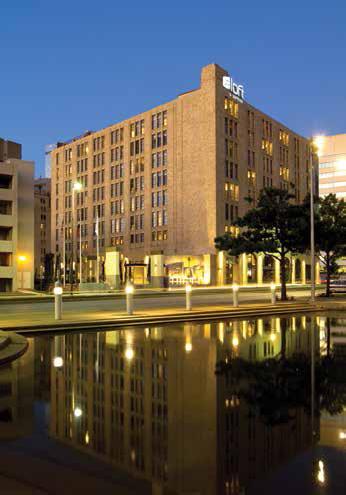 |
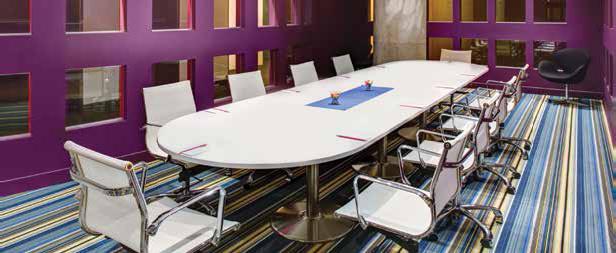 |
|
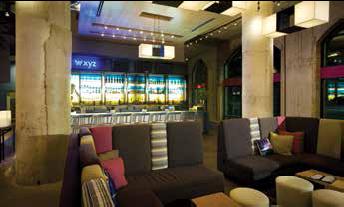 |
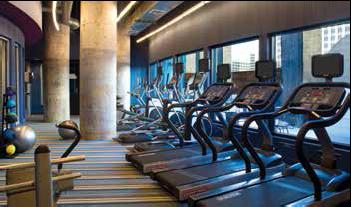 |
|
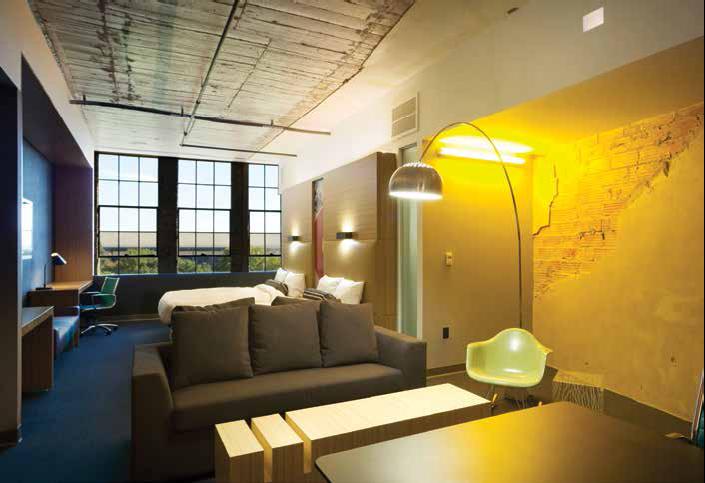 |
||






































